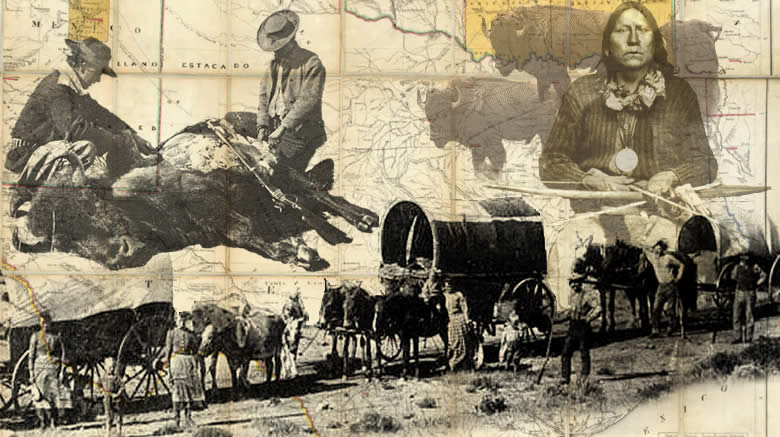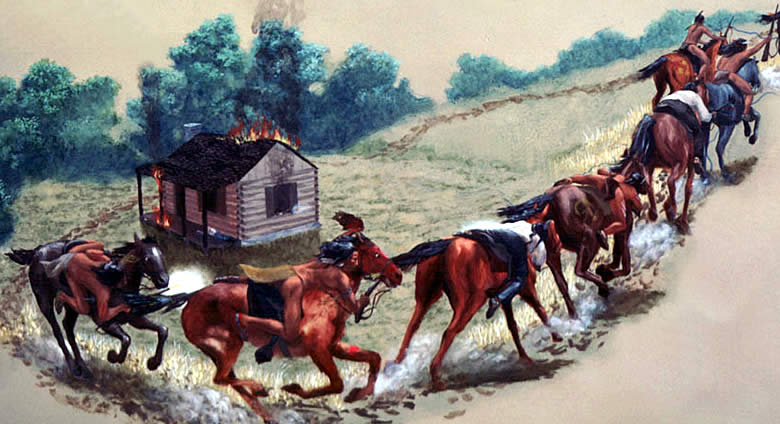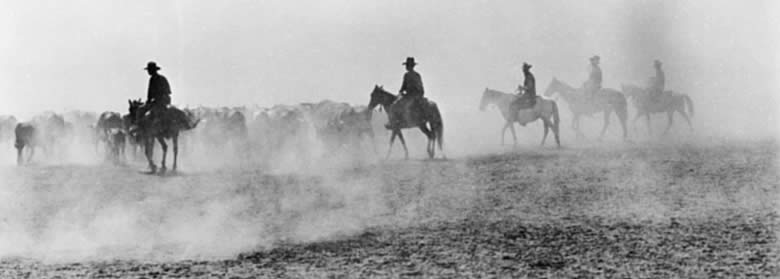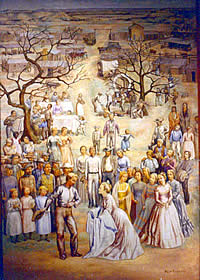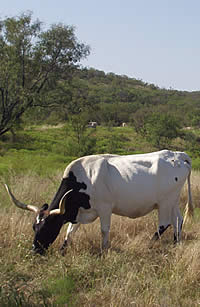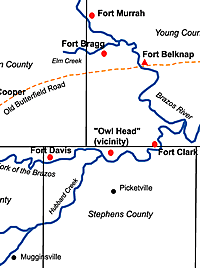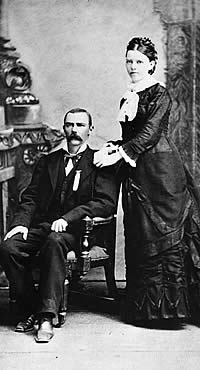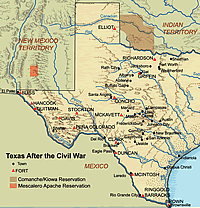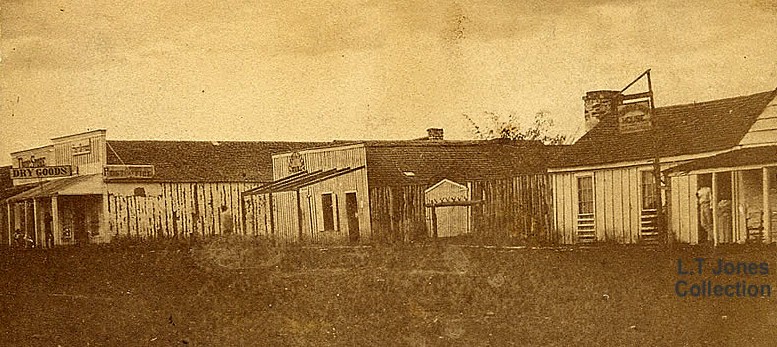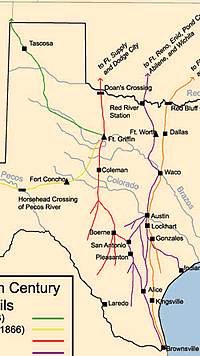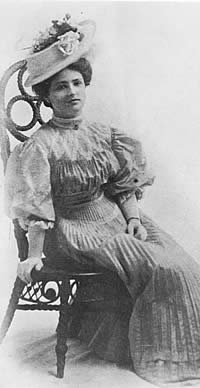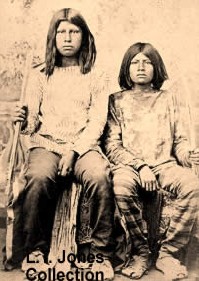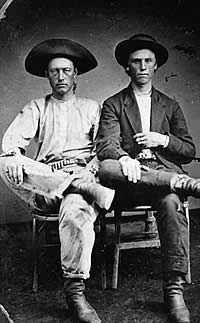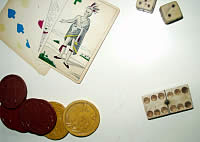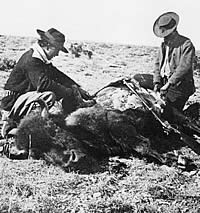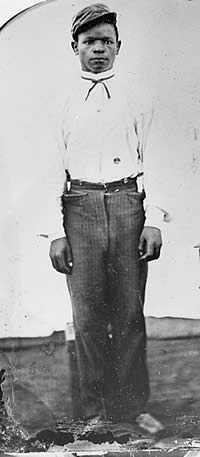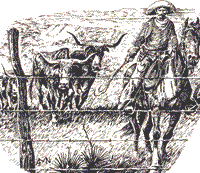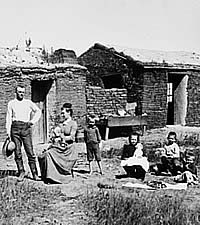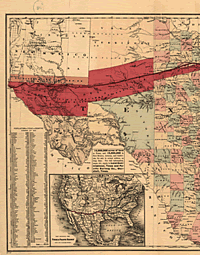|
It is not probable that white settlements will be
made here for a century to come, if ever.
-West Texas "beyond the treeline," U. S. Brig.
Gen. William G. Belknap, 1851.
|
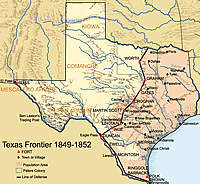
Area of settlements at the edge of
the western frontier circa 1849 to 1852 and the U.S.
forts constructed to protected them. Within a short
time, settlers moved beyond the lines of defense and
into unprotected lands. Click to enlarge.
|
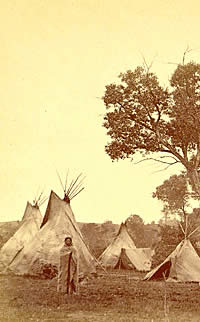
Comanche camp. Photo by William S. Soule, courtesy Wichita State University Library, A. A. Hyde Collection.
|
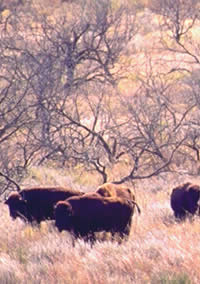
Bison, traditional sustenance for
the Plains tribes and later a rich commodity for Anglo
hide traders, were to come perilously close to extinction
by the end of the nineteenth century. Photo courtesy
Texas Parks and Wildlife Department.
|
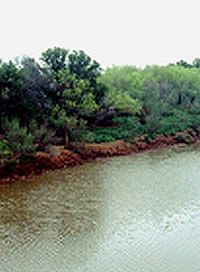
The fertile terraces of the Brazos River attracted settlers
who began small farms in the Peters Colony of northwest
Texas. |
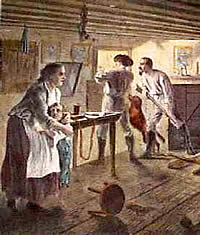
Western settlers being attacked by Indians. Small communities
on the edge of the frontier suffered the brunt of Indian
attacks in early years and served as a buffer for the
larger towns. Detail from Harpers Weekly, ca. 1870, click
to enlarge. |
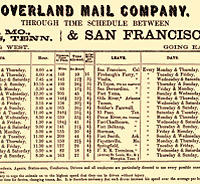
Schedule of stops along the Butterfield Line from Saint
Louis to San Francisoco. Note the stations at army forts
across Texas. Click to enlarge. |
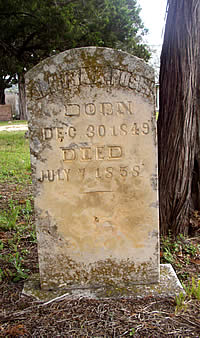
Diseases took as great a toll on settlers as they did
on Indians in some years, particularly young children
and the elderly. Gravestones, such as this one marking
the death of a child in the 1850s central Texas community
of Hoover Valley, are a poignant reminder of the harsh
frontier conditions. |
|
Anglo Texans greeted the end of the U.S-Mexican
War in 1848 with the hope that federal troops would at last
put an end to violent encounters with Indians and Mexicans
along the state's western and southern borders and open the
vast frontier to settlement. All too quickly the lure of nearly
free and unbroken land attracted a multitude of pioneers.
So rapidly, in fact, that it thrust some white settlers far
beyond the protection of the eight new military installations
established at war's end, running from Fort Worth in North
Texas to Fort Duncan on the Rio Grande.
In response, the U.S. Army in 1851 began establishing
a new line of forts a hundred miles beyond the original vanguard.
Others were located in the Big Bend country along the Rio
Grande and in extreme South Texas.
For Hispanics and Indians, who also claimed
much of this wild land as their home, the years of early statehood
left them struggling merely to survive. The Treaty of Guadalupe
Hidalgo that ended the late war cast many Tejanos into a perilous
future, with their new citizenship shadowed by an alien legal
system and powerful economic forces. Some would fight to hold
what they had, and find their recourse outside the law.
The situation for the Comanches was even more
ominous. The effects of contact had visited the Penateka (southern)
bands with lethal consequences. Dependence on the material
goods of Anglos and a taste for alcohol broke both tradition
and will. Epidemics of smallpox and other diseases passed
along by California-bound Argonauts and other trespassers
onto Comanchería left these once-fearsome Penatekas
staring hard at the prospect of extinction. Ecological changes,
moreover, upset the annual migration of the great bison herds,
a condition that would persist into the years of the Civil
War.
If that were not enough to spell the Penatekas'
doom, traditional Indian enemies—Lipan Apaches, Tonkawas,
and others—took advantage of this turn of fortune to
settle old scores. Still others—recent arrivals such
as Kickapoos, Delawares, and Shawnees—were swept onto
the West Texas frontier by the advance of Americans far beyond
the new state's borders. Armed with superior weaponry and
well tutored in double-dealing, they further contracted the
kingdom of these one-time Lords of the Plains.
To Anglos, so many unrestrained Indian tribes
and disgruntled Tejanos posed a psychological threat illuminated
by the very real prospect of actual raids. Northern Comanches,
joined by Kiowas and individuals from other tribes, splashed
across the Red River from the Indian Territory and often probed
the length of the frontier line, keeping settlers on constant
alert. Additionally, the usual run of rootless and lawless
whites took advantage of frontier conditions to prey upon
the livestock of isolated settlers.
On balance, the Texas frontier, like so much
of America's westward expansion, held promise in one hand
and peril in the other. Settlers bet their lives and property
on the wager that chaos would quickly give way to order. In
the estimation of these plucky newcomers, the prospective
rewards were certainly worth the risks. Like their predecessors,
the Spanish colonists who in the 1700s had settled the borderlands
along the Rio Grande, they learned that all manner of hardships
might be survived with a bit of luck and the support of neighbors,
though often far afield.
As the 1850s unfolded, signs of progress offered
encouragement. However meager, any number of villages sprang
up between the first and second line of U.S. posts from Gainesville
near the Red River, to Uvalde and Brackett above the Rio Grande.
The Peters Colony, established by the Republic-era legislature
in part to attract Ohio Valley families as a buffer against
the Penatekas, beckoned farmers who, on the grant's western
edges, tilled virgin soil along the fertile creek banks and
bottomlands of the Brazos and Trinity rivers. This expansive
watershed came to be known as Northwest Texas.
In the Hill Country area, German and Alsatian
emigrants continued to adapt their small-farming techniques
to Texas' expansive spaces. Settlements such as Fredericksburg,
New Braunfels and Castroville provided a bit of European culture
on the frontier in spite of continued threats of Indian attacks.
In 1858 the Southern Overland Mail, better known
as the Butterfield stage, began cutting a path across the
plains and prairies between its terminals at Saint Louis and
San Francisco. From Sherman to El Paso a series of stations
presented anchors around which communities seemed surely to
emerge.
Other newcomers to northern Texas learned that
the Western Cross Timbers, a veritable "cast iron forest,"
provided natural fencing. Indeed, many names later associated
with the great post-Civil War cattle empire—Hittson,
Goodnight, Slaughter, and others—seeded their first herds
on the tall grass of these rocky, but fertile prairies closed
in by the dense forests.
Just when it seemed as if the frontier was beginning
to join the mainstream of Texan society, Anglo-Indian conflicts
and the Civil War reversed most of this material progress.
Warrior bands—mostly from the Indian Territory—had
never ceased to probe the defensive gaps along the line of
the settlers' advance. For their part, the state and federal
governments were often at odds, flip-flopping between policies
of peace and war.
Adding to the sense of anxiety, the federal
government in 1854 leased four leagues of land for an Indian
reservation along the Brazos River below Fort Belknap. A second
reservation upstream was added for the Penatekas near Camp
Cooper, on the Clear Fork of the Brazos.
Many settlers expressed their admiration for
the Indians' efforts to take up farming and stock raising,
but others—more outspoken in their criticism—would
not be satisfied until the native peoples were either exterminated
or run out of Texas for good. While the rest of the state
was preoccupied with rumors of slave insurrections, frontierspeople
were stirred into the same kind of frenzy when a Jacksboro
weekly, The White Man, embarked on a sensational campaign
that preyed on settlers' fears and turned every rumor to fact.
The pioneers' sense of dread was somewhat allayed
in 1858 by news of two signal victories over their Plains
adversaries. That spring, Texans led by ranger captain Rip
Ford reported the defeat of over 300 determined warriors at
the Battle of the Washita, in Indian Territory. Not far from
there, near Wichita Village, U.S. Captain Earl Van Dorn routed
about 500 Comanches and Kiowas that fall.
Meanwhile, The White Man grew ever more
vocal. Words grew into deeds, climaxing in the Reservation
War of 1859 that pitted militiamen of Northwest Texas against
the Indians on both reservations. While no pitched battles
ensued, the affair resulted in the expulsion of the native
peoples.
At last it seemed as if Anglo Texans had gained
control of the frontier. The Civil War intervened, however,
proving that the worst of the settlers' troubles was only
beginning.
The Civil War cost pioneer folk both the protection of the
federal troops and much of its home guard, as many militiamen
took up arms and marched east to defend the South. Indians,
revitalized by feelings of revenge, took advantage of the
situation and attempted to reclaim their former homeland and
hunting grounds.
|
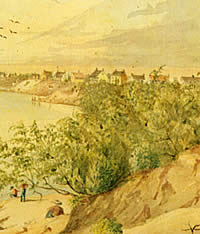
Rio Grande City, circa 1853. This
peaceful scene belies the violence that frequently erupted
in this and other early Texas border towns. As the artist-soldier
Capt. Arthur T. Lee wrote, Rio Grande City "could
boast more crimes of murder, robbery, assassination,
and outlawry generally, than all the rest of the Texas
cities… ." Detail of painting, courtesy of
the Rochester Historical Society. Click for full image.
|
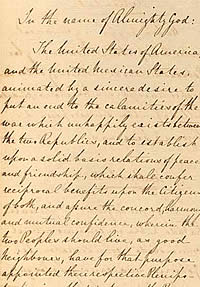
The Treaty of Guadalupe Hidalgo in
1848 brought the promise of peace between the United
States and Mexico. For many Tejanos, however, the treaty
brought an alien legal system along with a change in
citizenship. Some victims of the new economic and political
order fought back outside the law. Treaty (page 1),
courtesy the Library of Congress. Click to enlarge.
|
|
On balance, the Texas frontier, like so much of
America's westward expansion, held promise in one hand
and peril in the other. Settlers bet their lives and
property on the wager that chaos would quickly give
way to order.
|
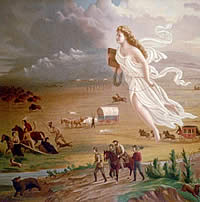
Hovering goddess-like above the
westward moving pioneers, this allegorical female came
to symbolize the virtue of taming the western frontier,
what some considered America's "manifest destiny."
Painting entitled, "American Progress," by
George Crogutt, 1873. Image courtesy of the Library
of Congress.
|
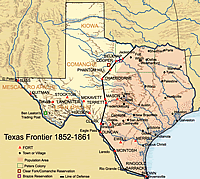
As settlers pushed farther west on the Texas frontier
in the 1850s, new army posts were constructed to provide
a measure of protection. Click to enlarge. |
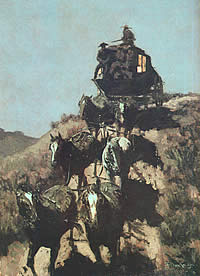
"The Old Stagecoach of the Plains."
The coming of the Butterfield stage line to Texas, with
its series of passenger stops, provided further anchors
for settlement along the frontier. Painting by Frederick
Remington, Amon Carter Museum, Fort Worth.
|
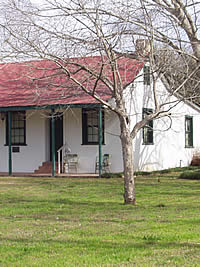
Substantial houses of stone and plaster
with a European flair were built in early settlements
such as Castroville. The house shown is that of Henri
Castro, founder of the 1840s colony west of San Antonio.
Click to see full image.
|
|
